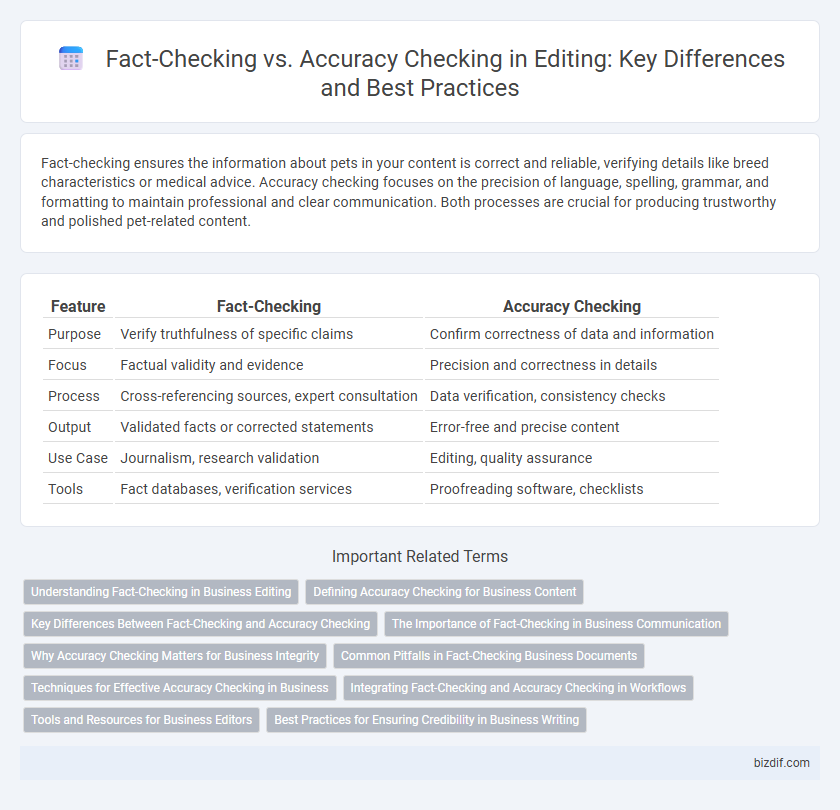Fact-checking ensures the information about pets in your content is correct and reliable, verifying details like breed characteristics or medical advice. Accuracy checking focuses on the precision of language, spelling, grammar, and formatting to maintain professional and clear communication. Both processes are crucial for producing trustworthy and polished pet-related content.
Table of Comparison
| Feature | Fact-Checking | Accuracy Checking |
|---|---|---|
| Purpose | Verify truthfulness of specific claims | Confirm correctness of data and information |
| Focus | Factual validity and evidence | Precision and correctness in details |
| Process | Cross-referencing sources, expert consultation | Data verification, consistency checks |
| Output | Validated facts or corrected statements | Error-free and precise content |
| Use Case | Journalism, research validation | Editing, quality assurance |
| Tools | Fact databases, verification services | Proofreading software, checklists |
Understanding Fact-Checking in Business Editing
Fact-checking in business editing involves verifying all data, statements, and references against reliable sources to ensure the content's credibility and prevent misinformation. It requires rigorous cross-referencing of financial figures, company names, dates, and industry-specific facts to maintain trust and authority in professional communication. Accurate fact-checking enhances brand reputation and supports informed decision-making by stakeholders.
Defining Accuracy Checking for Business Content
Accuracy checking in business content involves systematically verifying facts, figures, and data to ensure correctness and reliability. It focuses on confirming that information such as statistics, dates, names, and financial details precisely reflect the source material without errors. This process enhances credibility, maintains professional integrity, and prevents misinformation that could impact business decisions or reputation.
Key Differences Between Fact-Checking and Accuracy Checking
Fact-checking involves verifying the truthfulness of information against reliable sources to ensure factual correctness, while accuracy checking focuses on the precision and correctness of specific details such as dates, names, statistics, and quotations within the text. Key differences include fact-checking's broader scope, targeting the validation of claims and statements, whereas accuracy checking is concerned with the exactness of data and adherence to source material. Effective editorial processes integrate both practices to enhance overall content reliability and credibility.
The Importance of Fact-Checking in Business Communication
Fact-checking in business communication ensures the reliability of information, preventing the spread of misinformation that could damage a company's reputation. Rigorous verification of data, sources, and claims strengthens credibility and supports informed decision-making among stakeholders. Accurate fact-checking mitigates legal risks and enhances transparency, fostering trust between businesses and their clients or partners.
Why Accuracy Checking Matters for Business Integrity
Accuracy checking ensures that all business communications, data, and published content are free from errors and inconsistencies, directly supporting the company's credibility and trustworthiness. Rigorous accuracy checks help prevent costly misinformation, legal issues, and reputational damage by verifying facts, figures, and operational details before release. This process strengthens stakeholder confidence and upholds the integrity essential for sustained business success.
Common Pitfalls in Fact-Checking Business Documents
Common pitfalls in fact-checking business documents include relying on outdated sources, misinterpreting data context, and overlooking subtle inaccuracies in financial figures or legal terms. Confusing fact-checking with accuracy checking often leads to missed errors, as fact-checking verifies the truth of information while accuracy checking ensures correct presentation and consistency. Effective business document editing demands both rigorous fact verification and detailed accuracy assessments to maintain credibility and compliance.
Techniques for Effective Accuracy Checking in Business
Effective accuracy checking in business editing relies on cross-referencing data with multiple credible sources, including official records, industry reports, and verified databases. Utilizing digital tools such as automated fact-checking software and plagiarism detectors enhances precision by quickly identifying inconsistencies or errors in financial statements, contracts, and marketing materials. Regular training on verification techniques and maintaining standardized checklists ensures consistent application of these methods, reducing the risk of misinformation and enhancing overall corporate credibility.
Integrating Fact-Checking and Accuracy Checking in Workflows
Integrating fact-checking and accuracy checking in editorial workflows enhances the reliability of published content by systematically verifying information and ensuring consistency throughout the text. Employing comprehensive databases and automated tools within this integration facilitates identifying discrepancies early, reducing errors prior to publication. Streamlined collaboration between fact-checkers and accuracy editors optimizes validation processes, resulting in higher editorial standards and audience trust.
Tools and Resources for Business Editors
Fact-checking tools for business editors include platforms like Factiva, LexisNexis, and Snopes, which provide access to verified news sources and databases crucial for verifying corporate information and market data. Accuracy checking involves software such as Grammarly and Hemingway Editor that refine grammar, style, and numerical consistency, ensuring clear and error-free communication in business documents. Combining these resources enhances editorial integrity by cross-verifying facts and polishing presentation to meet professional standards.
Best Practices for Ensuring Credibility in Business Writing
Fact-checking involves verifying the truthfulness of data, statistics, and statements from reliable sources, while accuracy checking ensures correct grammar, spelling, and consistency in business writing. Best practices include cross-referencing information with authoritative databases, using plagiarism detection tools, and applying style guides like the AP Manual to maintain clear and credible communication. Implementing a dual-layer review process enhances trustworthiness and professionalism, crucial for effective business correspondence.
Fact-Checking vs Accuracy Checking Infographic

 bizdif.com
bizdif.com